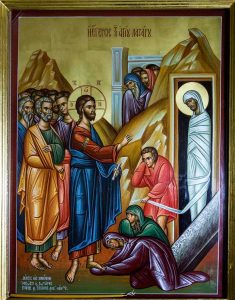As the destiny for the Mother of God, so for us.
Today the universe, rejoicing mystically in thy glorious memorial, O Theotokos, doth go before crying and shouting with joy: Rejoice, O Virgin, pride of Christians! (Kontakion)
 We liturgically honor one of the 20th century’s greatest saints, Maximilian Kolbe, who points out for the meaning of the “the victory that overcomes the world, our faith.”
We liturgically honor one of the 20th century’s greatest saints, Maximilian Kolbe, who points out for the meaning of the “the victory that overcomes the world, our faith.”
“Father Maximilian voluntarily offered himself for death in the starvation bunker for a brother, and so won a spiritual victory like that of Christ himself. This brother still lives today in the land of Poland and is here with us” (John Paul II, June 7, 1979).
Saint Maximilian, pray for us.
 Today, on the 19th Sunday through the Church Year, we hear the gospel reading where Jesus walks on the water. We are moving through the summer…and what the Church gives to us to meditate upon is keen these days.
Today, on the 19th Sunday through the Church Year, we hear the gospel reading where Jesus walks on the water. We are moving through the summer…and what the Church gives to us to meditate upon is keen these days.
St. Augustine reminds us, “If you feel your foot slipping beneath you, if you become a prey to doubt or realise that you are losing control, if, in a word, you begin to sink, say: Lord, I am drowning, save me! Only he who for your sake died in your fallen nature can save you from the death inherent in that fallen nature.”
Jesus, I trust in you.
 The Church honors the memory of St. Clare of Assisi (1193/94-1253), liturgically, today. She is known as the first woman to join St. Francis and his companions in their new form of living the Gospel in a radical way.
The Church honors the memory of St. Clare of Assisi (1193/94-1253), liturgically, today. She is known as the first woman to join St. Francis and his companions in their new form of living the Gospel in a radical way.
Clare met Francis who impressed upon her the virtue –not just a value– of being a part of what he determined to be a life of penance and “life according to the Holy Gospel”. Called by God, Clare decided to abandon her family and social status, like Francis and his companions, in 1211 or 1212 be a part of the new movement. Her “Franciscan” life first was lived in her family home but later moved to a more fitting environment. It was Francis who taught:
“Since by divine inspiration you have made yourselves daughters and servants of the most High King, the heavenly Father, and have taken the Holy Spirit as your spouse, choosing to live according to the perfection of the Holy Gospel, I resolve and promise for myself and for my brothers always to have the same loving care and special solicitude for you as I have for them.”
As she wrote to St. Agnes of Prague: “If so great and good Lord, then, on coming into the Virgin’s womb, chose to appear despised, needy, and poor in this world, so that people who were in utter poverty and want, suffering hunger for heavenly nourishment, might become rich in him by possessing the kingdom of heaven, then rejoice and be glad! . . What a great and praiseworthy exchange: to leave the things of time for those of eternity, to choose the things of heaven for the goods of earth, to receive the hundred-fold in place of one, and to possess a blessed and eternal life!”
The early sisters of Clare lived simply and prayerfully at the Church of San Damiano for over 40 years, sustained by their own work. The her monastic Rule was finally approved by Pope Innocent IV shortly before her death in 1253. She was canonized two years later in 1255.
On the mountain You were transfigured, O Christ God, and Your disciples beheld Your glory as far as they could see it; so that when they would behold You crucified, they would understand that Your suffering was voluntary, and would proclaim to the world that You are truly the Radiance of the Father (Kontakion for the Transfiguration).
The Transfiguration of Our Lord, as testified to in Divine Revelation shows us our ultimate destiny as Christians: the ultimate destiny of all men and all creation to be transformed and glorified by the splendor of God Himself.
On the feast of the Transfiguration on August 6th, is a summer celebration and expectation of Great Lent, of the Eucharist, the Cross, and the Resurrection. The Church blesses grapes, as well as other fruits, on the Transfiguration is a beautiful sign of our final transfiguration of all things in Jesus Christ. We bless grapes because we bless God! The gesture of bringing and blessing of grapes points to the ultimate flowering and fruitfulness (generativity) of all creation in the Paradise; here we all will be transformed in the garden by the glory of the Lord.
Bunches of grapes are symbols of completion —especially experienced in the completion of the growing season— which has finally brought things to fruition. Christians see in the grapes the biblical image of Jesus as the Vine.
In the Bible we read of the custom of bringing fruit to the temple for consecration (Genesis 4:2-4; Ex 13:12-13; Numbers 15:19-21; Deuteronomy 8:10-14). In the New Testament the 12 Apostles brought this tradition to the Church (1 Corinthians 16:1-2). Later in the early centuries of Christianity, the faithful brought to the Church fruits and vegetables of the new harvest: bread, wine, oil, incense, wax, honey, etc. Some of the offerings were taken to the altar, and the balance made available to needs of the clergy and the poor.
Hence, grapes ought to remind us that by our life we are known for our service to others. Thus, the grapes remind us that we should not be sour grapes for others.
 Benedictines celebrate today as the memorial of Saints Mary, Martha and Lazarus- Hosts of the Lord. Models par excellence of what the Rule of Saint Benedict says about receiving guests as Christ Himself. Divine revelation, likewise, reveals to us that the Lord was received by his friends to tomb of Lazarus, but before this point, he was received by the holy siblings to their home.
Benedictines celebrate today as the memorial of Saints Mary, Martha and Lazarus- Hosts of the Lord. Models par excellence of what the Rule of Saint Benedict says about receiving guests as Christ Himself. Divine revelation, likewise, reveals to us that the Lord was received by his friends to tomb of Lazarus, but before this point, he was received by the holy siblings to their home.The Monastic Fathers attest to the fact that this gospel reading begs us all to take up the calling that all three live. A particular witness to this teaching is Saint Bernard who says that each monk (and by extension to the Oblate) must unite in himself “all three vocations: that of the penitent, the active worker and the contemplative.” We hear Jesus’ call to come out of the tomb of our sinfulness into the light of his mercy as did Lazarus. Likewise the call is lived when we serve one another in love as Martha. Moreover, we ought to attend to Jesus Christ, we listen (a virtue echoed by the Holy Rule) to his words and cherish them in our hearts like Mary. The three ways of love can lead us to choose the “better part,” which Jesus promises shall not be taken from us.
I am firm believer, based on experience AND the witness of Tradition of the Church, and that of Benedict XVI, that Lectio Divina is the prime method of my daily spiritual renewal. It is the daily re-birth of my life in Jesus Christ. My hope is that I can be faithful to the practice. Here is a fine thought on value of Lectio:
The monastic art of the reading (lectio) which is really a kind of listening (“with the ear of the heart”, cf. Rule of Benedict) to what the Word of God is saying to us in the Scriptures. They were also given time and space to immerse themselves in the practice of this art and to share their experience with one another and some of the monks. And all, of course, took place within the daily round of prayer and work which make up the life of the monastery ( or, in the home and workplace, among friends).